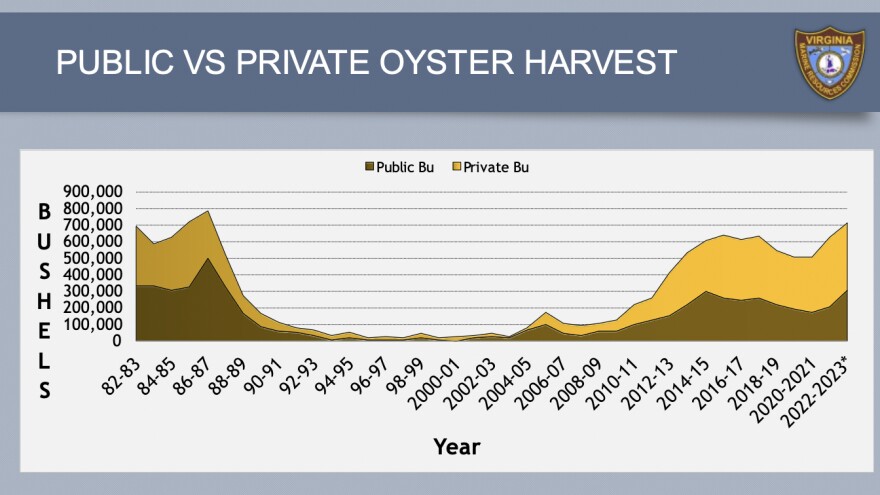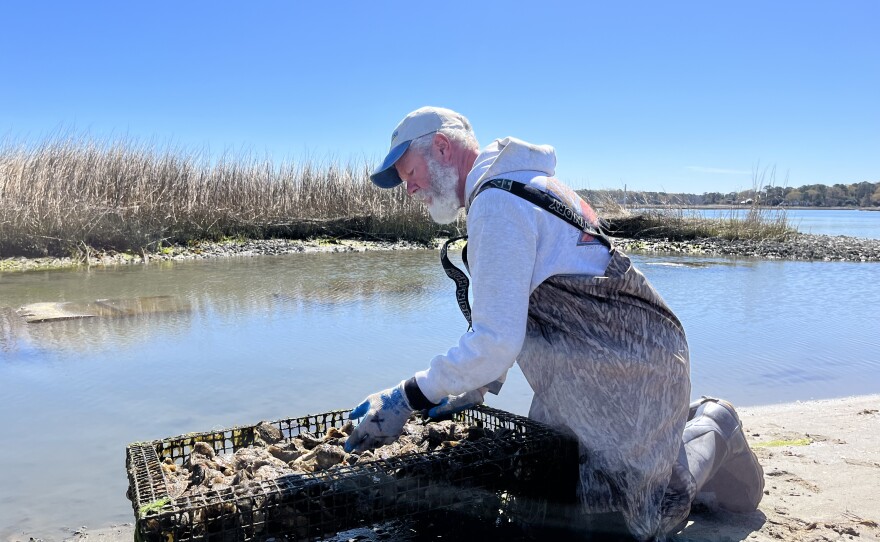The oyster population in the Chesapeake Bay and its tributaries has come a long way since it collapsed in the late ’80s.
A combination of overfishing, disease and other factors led to a drop in the population during the 20th century. But early in the 1900s, harvesters pulled millions of bushels — about 100 oysters each — from waterways every season. By the early ’90s, some seasons yielded fewer than 20,000 bushels.
“The resource almost slipped through our hands forever,” said Jackie Shannon, Virginia oyster restoration manager at the Chesapeake Bay Foundation.
During the 2022-'23 season, harvesters gathered about 700,000 bushels — the most in 35 years, according to the Virginia Marine Resources Commission.
“It is huge,” said Mike Hutt, executive director of the Virginia Marine Products Board. “It's not where we were back in the ’30s, ’40s and ’50s, and early ’60s, but Virginia is back in the oyster business.”
Hutt, who’s worked in the seafood industry for 44 years, said Virginia now produces more oysters yearly than any other East Coast state — a fact he attributed to decades of population management and environmental work.
In the most recent season, 300,000 bushels of oysters were harvested from public waters. The state manages those waters by monitoring oyster abundance and health, and regularly rotating which public waters are open for harvesting.

Regulators also set rules about how oysters can be harvested, sometimes limiting fishers to using less disruptive tools in certain areas. One tool that's widely used are hand tongs — similar to kitchen tongs, but about 10 feet tall with a large metal cage on the end for scooping oysters out of the water. That tool has a lower impact on the ecosystem than using techniques like dredging. Regulators take it a step further in some fishing areas, only allowing harvesting by hand.
Private farms — which yielded 400,000 bushels last season — have also contributed to the revival by stocking their waters with healthy, disease-free oysters.
Hutt said that helps create heathy ecosystems.
“We've got over 200 active growing companies doing agricultural oysters today, [and] every adult oyster can filter up to 50 gallons of water a day,” Hutt said.
Shannon said oysters are “basically like the coral reefs of the Chesapeake Bay,” providing habitat for dozens of other critters.
She was out on the water Monday, monitoring oyster reefs in Norfolk’s Lafayette River. Shannon works with hundreds of volunteers every year to stock reefs around the Bay ecosystem with about 10 million spat — oyster larvae that attach to the surface they’ll spend their lives on.
No oysters are harvested from the reefs she surveyed, but their offspring can establish nearby reefs that commercial operations can take advantage of, leading to larger seasonal yields.
Now, state regulators are cautiously expanding access to harvesting grounds; they helped harvesters reach last season’s milestone by extending oyster season by two weeks.
There were also more people harvesting oysters last season than in the past, contributing to the increased haul. According to the USDA, there were 60 oyster farms in the commonwealth in 2018, compared to 134 in 2016. Today, there are over 200, according to Hutt. And regulators expect the number to grow 7%-15% this season.
Shannon contributed to decisions like the extension of the season. She serves on the Shellfish Management Advisory Committee, where she said she’s one of the only members not affiliated with the fishing industry.
“I'm kind of like the voice of conservation, but I certainly don't feel like the Lone Ranger,” she said, noting that most committee members have seen their businesses affected by the oyster population’s collapse.
Although she said a season extension should not be regular practice, Shannon said the science justified the move last year.
She was glad to see the industry reach a milestone.
“Part of it is the result of huge restoration efforts and in a conservation mindset by the state of Virginia,” Shannon said.
The Bay foundation is supporting bills at the General Assembly this year that Shannon said would support healthy aquatic ecosystems generally — such as measures to increase vegetated buffers around bodies of water. Shannon also said she hopes to see lawmakers set aside money for a statewide population survey.
Oyster season in Virginia is ongoing and ends at different times in different bodies of water, but most harvesting will be wrapped up by April.



